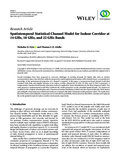| dc.contributor.author | Oyie, Nicholas O. | |
| dc.contributor.author | Afullo, T. J. O. | |
| dc.date.accessioned | 2021-04-21T12:24:09Z | |
| dc.date.available | 2021-04-21T12:24:09Z | |
| dc.date.issued | 2018-12 | |
| dc.identifier.citation | Wireless Communications and Mobile Computing Volume 2018, Article ID 9656029, 10 pages https://doi.org/10.1155/2018/9656029 | en_US |
| dc.identifier.uri | https://www.hindawi.com/journals/wcmc/2018/9656029/ | |
| dc.identifier.uri | https://dl.acm.org/doi/abs/10.1155/2018/9656029 | |
| dc.identifier.uri | https://www.researchgate.net/publication/329536514_Spatiotemporal_Statistical_Channel_Model_for_Indoor_Corridor_at_14_GHz_18_GHz_and_22_GHz_Bands | |
| dc.identifier.uri | https://www.x-mol.com/paper/1225083482457817088?recommendPaper=1225121484554944512 | |
| dc.identifier.uri | https://jglobal.jst.go.jp/en/detail?JGLOBAL_ID=201902244239672040 | |
| dc.identifier.uri | https://www.semanticscholar.org/paper/Spatiotemporal-Statistical-Channel-Model-for-Indoor-Oyie-Afullo/15d12576a16aa40504be682e531ecf70bdd95b4d | |
| dc.identifier.uri | http://hdl.handle.net/123456789/4596 | |
| dc.identifier.uri | https://doi.org/10.1155/2018/9656029 | |
| dc.description.abstract | Several techniques have been proposed to overcome challenges of meeting demands for higher data rates in wireless communication. Space-time diversity method is proposed to exploit spatiotemporal nature of the channel; hence, a comprehensive knowledge of the spatiotemporal properties of a channel is required. In this paper, a measurement-based channel model that considers both delay and angular domains of an indoor corridor channel for 14 GHz, 18 GHz, and 22 GHz is proposed. A nonparametric Gaussian kernel density estimation method is applied for cluster identification for the three frequency bands. This work proposes a spatiotemporal model that conditions the model parameters on the azimuthal spatial domain. The clusters are modeled on the complete azimuth plane and a Gaussian estimation distribution is fitted onto the empirical data plot. Both clusters and multipath components are modeled and results are compared with Saleh-Valenzuela model parameter values. The results show that both clusters and multipath components can be estimated by probability density functions that follow Gaussian and Laplacian fits on the spatial domain for indoor corridor environment, respectively. | en_US |
| dc.language.iso | en | en_US |
| dc.publisher | Wiley | en_US |
| dc.title | Spatiotemporal Statistical Channel Model for Indoor Corridor at 14 GHz, 18 GHz, and 22 GHz Bands | en_US |
| dc.type | Article | en_US |

